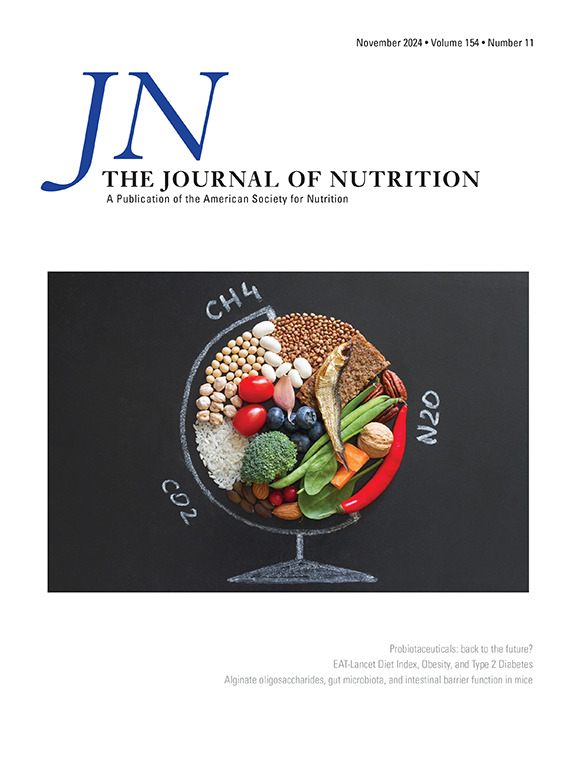In Vitro Treatment with Metformin Significantly Reduces Senescent B Cells Present in the Adipose Tissue of People with Obesity
IF 3.8
3区 医学
Q2 NUTRITION & DIETETICS
引用次数: 0
Abstract
Background
Our previous work has shown that senescent B cells accumulate in the human adipose tissue (AT) of people with obesity, where they express transcripts for markers associated with the senescence-associated secretory phenotype (SASP) and secrete multiple inflammatory mediators. These functions of AT-derived B cells are metabolically supported.
Objectives
To show that Metformin (MET), a widely used hypoglycemic and antidiabetic drug, is able at least in vitro to decrease frequencies, secretory profile, and metabolic requirements of senescent B cells isolated from the AT of people with obesity.
Methods
We recruited adult females with obesity (n = 8, age 40 ± 2 y, BMI range: 33–42) undergoing breast reduction surgery, who donated their discarded subcutaneous AT. B cells from stromal vascular fractions isolated after collagenase digestion of the AT were evaluated after in vitro incubation with MET (1 mM × 106 B cells) or with a control medium without MET for the following measures: expression of transcripts for SASP-associated markers (p16INK4a and p21CIP1/WAF1) measured by quantitative polymerase chain reaction (qPCR); secretion of inflammatory cytokines (TNF-α, IL-6, IFN-γ and IL-17A) measured by a Cytometric Bead Array); metabolic characteristics as identified by a glycolytic test and Seahorse technology, and by the expression of transcripts for glucose transporters and metabolic enzymes involved in glucose metabolic pathways, measured by qPCR. To examine differences between MET-treated compared with untreated groups, paired Student’s t tests (two-tailed) were employed.
Results
MET in vitro was able to reduce frequencies and numbers of senescent B cells, as identified by staining with β-galactosidase, as well as the secretion of inflammatory cytokines, the expression of transcripts for SASP, and metabolic markers that support intrinsic B cell inflammation.
Conclusions
Our results provide evidence to support the beneficial effects of MET in reducing AT-related inflammation through its effects on senescent B cells.
用二甲双胍进行体外治疗,可明显减少肥胖症患者脂肪组织中的衰老 B 细胞。
背景:我们之前的研究表明,衰老的 B 细胞在肥胖症患者的人体脂肪组织(AT)中聚集,它们在其中表达与衰老相关分泌表型(SASP)相关的标记转录物,并分泌多种炎症介质。AT源性B细胞的这些功能是由新陈代谢支持的:目的:证明二甲双胍(MET)--一种广泛使用的降血糖和抗糖尿病药物--至少能在体外降低从肥胖症患者的AT中分离出的衰老B细胞的频率、分泌特征和代谢要求:方法:我们招募了接受乳房缩小手术的成年肥胖女性(8 人,年龄 40±2 岁,体重指数范围 33-42),她们捐献了废弃的皮下乳腺组织。在与 MET(1 mMx106 B 细胞)或培养基体外培养后,评估了经胶原酶消化 AT 后从基质血管馏分(SVFs)中分离出的 B 细胞。通过 qPCR 测量 SASP 相关标记物(p16INK4a 和 p21CIP1/WAF1)的表达;通过 Cytometric Bead Array 测量炎性细胞因子(TNF-α、IL-6、IFN-γ 和 IL-17A)的分泌;)通过糖酵解测试和 Seahorse 技术,以及通过 qPCR 测量葡萄糖转运体和葡萄糖代谢途径中的代谢酶转录本的表达,确定代谢特征。为了检验 MET 处理组和未处理组之间的差异,采用了配对学生 t 检验(双尾):结果:体外 MET 能够降低衰老 B 细胞的频率和数量(用 β-半乳糖苷酶染色确定),并减少炎性细胞因子的分泌、SASP 转录物的表达以及支持 B 细胞内在炎症的代谢标记物的表达:我们的研究结果为 MET 通过影响衰老的 B 细胞来减少 AT 相关炎症的有益作用提供了证据。
本文章由计算机程序翻译,如有差异,请以英文原文为准。
求助全文
约1分钟内获得全文
求助全文
来源期刊

Journal of Nutrition
医学-营养学
CiteScore
7.60
自引率
4.80%
发文量
260
审稿时长
39 days
期刊介绍:
The Journal of Nutrition (JN/J Nutr) publishes peer-reviewed original research papers covering all aspects of experimental nutrition in humans and other animal species; special articles such as reviews and biographies of prominent nutrition scientists; and issues, opinions, and commentaries on controversial issues in nutrition. Supplements are frequently published to provide extended discussion of topics of special interest.
 求助内容:
求助内容: 应助结果提醒方式:
应助结果提醒方式:


